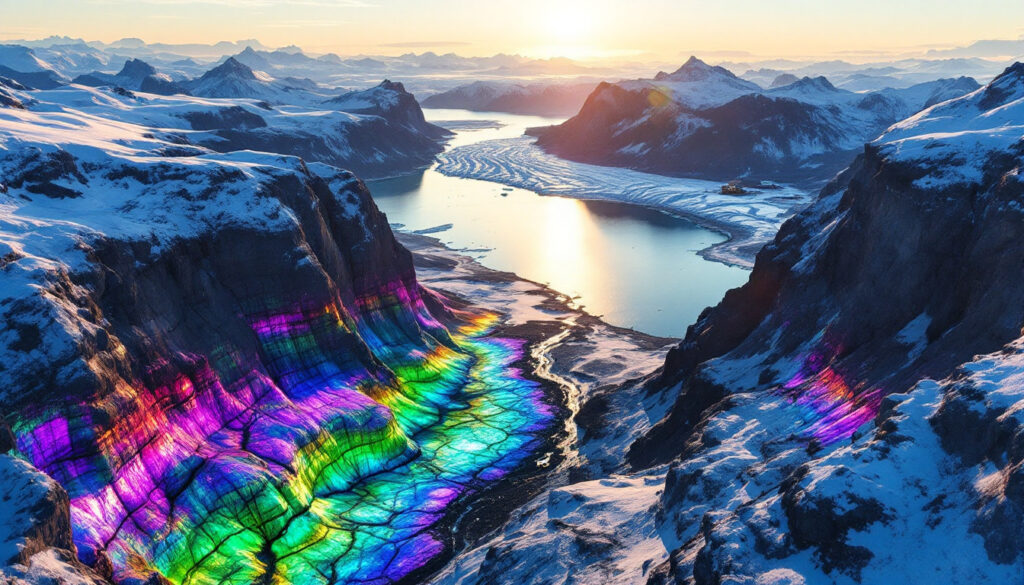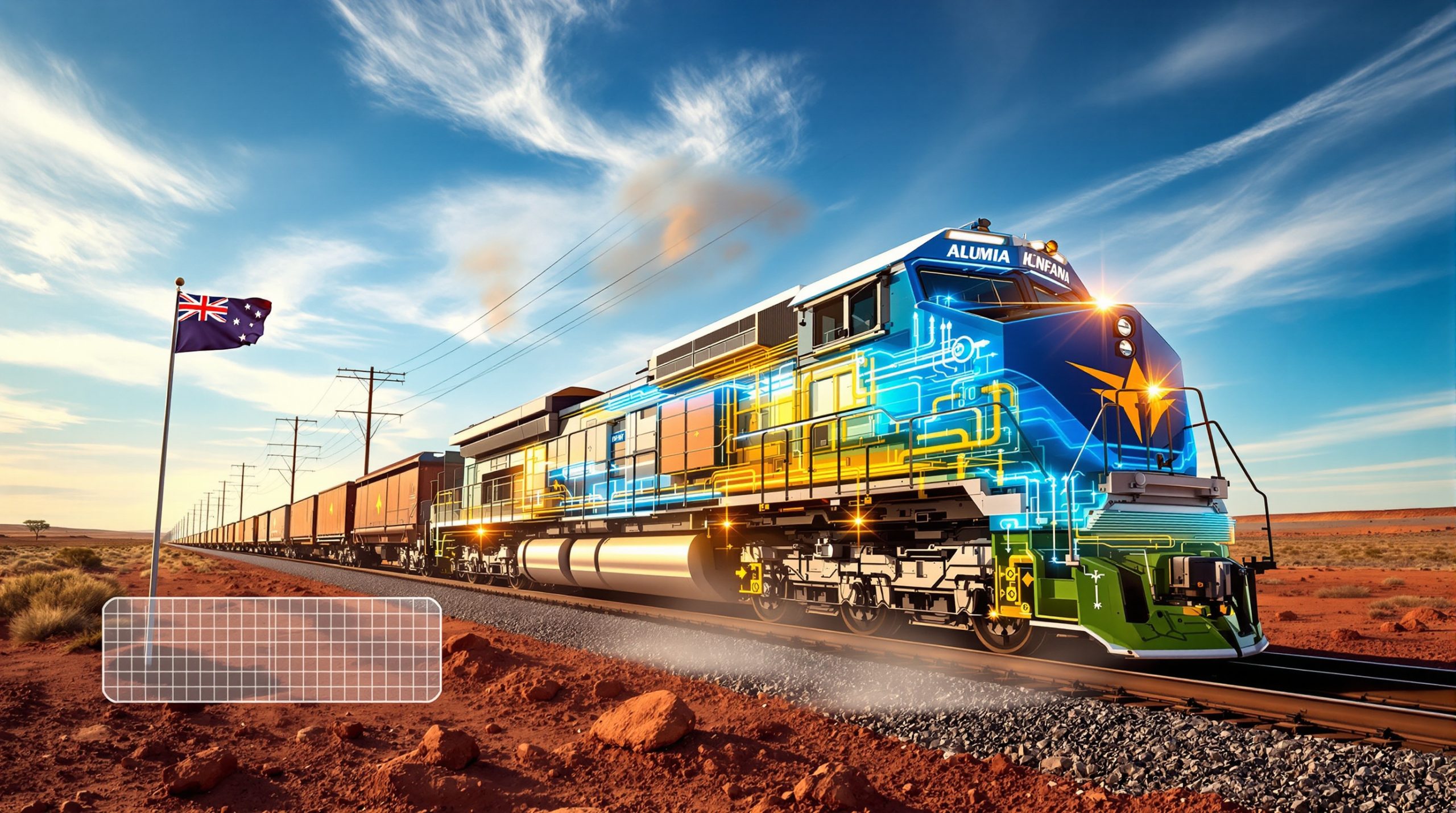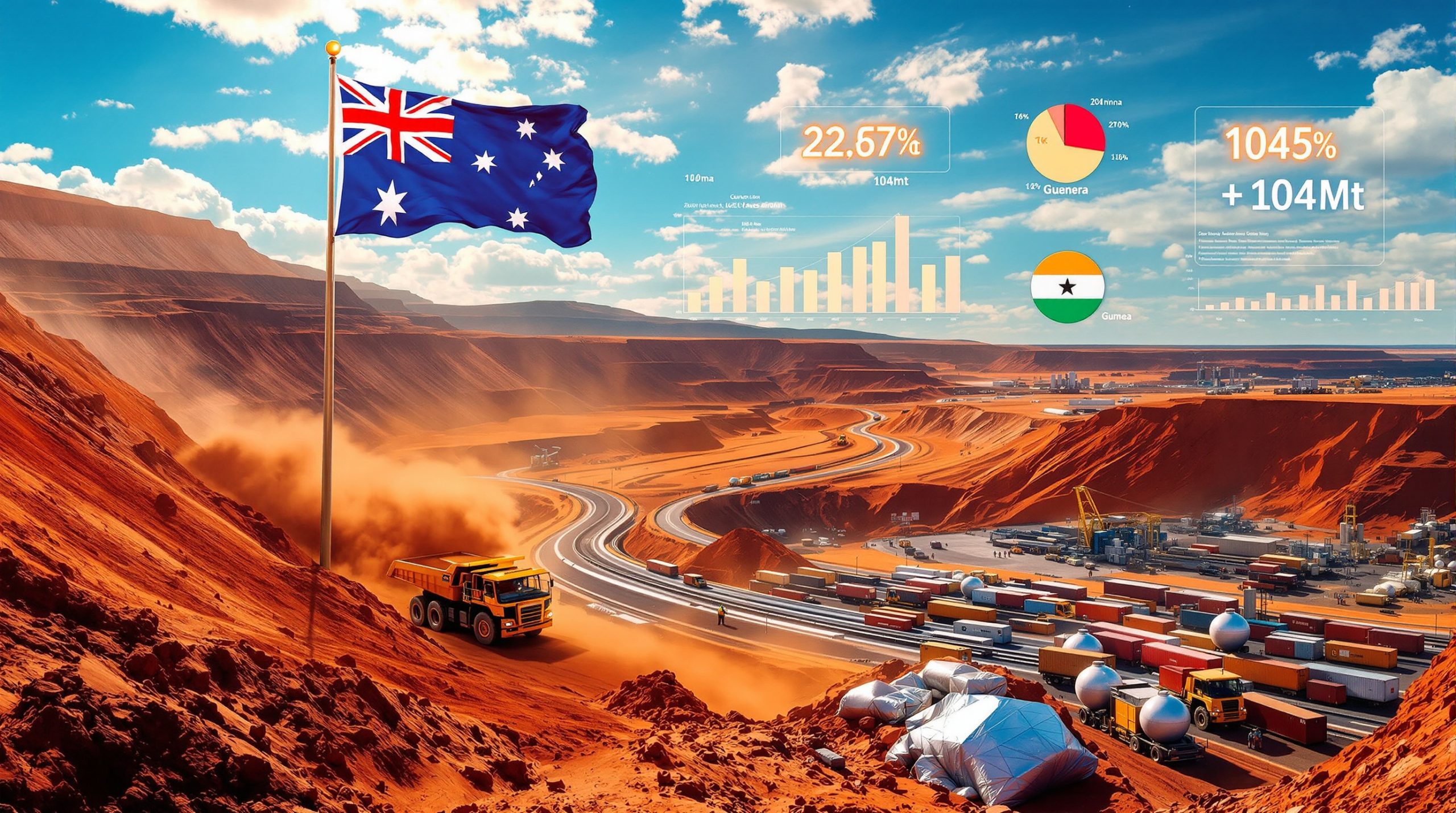Greenland: The Frozen Frontier of Critical Minerals
Greenland, the world's largest island at 2.17 million km², has emerged as a critical minerals frontier despite its remote location and harsh climate. Covering approximately 24% of the United States' size, this self-governing Danish territory hosts an extraordinary geological diversity beneath its ice sheet, which covers 81% of the landmass. With increasing global competition for Greenland and critical minerals and rare earth elements, the island's largely untapped resources have attracted international attention from major powers, including the United States and China.
Greenland's Unique Geological Landscape
Greenland's geological significance stems from its remarkable age and diversity. The island hosts some of Earth's oldest rocks, dating back approximately 3.8 billion years, providing a unique window into our planet's early formation. Unlike other mineral-rich regions, Greenland offers exceptional bedrock exposure due to minimal vegetation, making geological study more accessible despite the harsh conditions.
The variety of resources is equally impressive, with deposits of base metals (copper, zinc, lead), precious metals (gold, silver), rare earth elements, lithium, graphite, gemstones, uranium, and industrial minerals. Most intriguingly, climate change is continuously revealing new bedrock and potential resource areas as glaciers retreat, creating a dynamic exploration landscape that changes year by year.
Geopolitical Significance of Greenland's Minerals
Greenland's strategic importance extends well beyond its geological treasures. Multiple U.S. administrations have attempted to acquire Greenland over the past 150 years, culminating in former President Trump's highly publicized 2019 interest in purchasing the territory. This historical pattern underscores Greenland's enduring geopolitical value.
The American military maintains a significant presence at Pituffik Space Base (formerly Thule Air Base), established during World War II partly to secure access to strategic minerals like cryolite. Meanwhile, Chinese investment has been actively courted by Greenland's government, creating a new front in the ongoing strategic competition between these superpowers.
For Greenland's approximately 57,000 residents, currently reliant on $600 million in annual Danish subsidies, mineral wealth represents a potential economic foundation for full independence—a national aspiration that adds political complexity to mining decisions. Trump's Policy Influence on Global Commodity Markets has further highlighted the importance of Greenland's resources in international relations.
Current Mining Operations in Greenland
Despite its vast mineral potential, Greenland currently hosts only two active mining operations, highlighting the gap between potential and development.
Nalunaq Gold Mine
The Nalunaq mine, owned by Amaroq Minerals, stands as one of the world's highest-grade gold mines with an extraordinary 28g/t grade. With inferred resources of 355,000 tonnes, the mine has historically produced 367,000 ounces between 2004-2013 before temporary closure. The deposit is classified as orogenic gold, with mineralization concentrated in narrow, structurally controlled quartz veins that require precision drilling techniques.
After years of development work, Nalunaq resumed production in late 2024 under Amaroq's ownership. The company has implemented advanced mining methods specifically adapted to the narrow vein structure, exemplifying how digital transformation driving mining innovation can overcome Greenland's geological challenges.
White Mountain (Qaqortorsuaq) Anorthosite Mine
The White Mountain mine, operated by Lumina Sustainable Materials, represents a small-scale but scientifically fascinating operation producing several hundred tonnes of anorthosite annually. The deposit contains exceptionally pure anorthosite (>90% calcium-rich plagioclase), making it valuable for specialized industrial applications.
This material serves primarily in fiberglass production but has growing potential as an alternative aluminum source with a significantly lower carbon footprint compared to traditional bauxite processing. Perhaps most intriguing is its geological significance—the anorthosite shares a remarkably similar composition to lunar highlands, earning it the nickname "moon rock of Greenland" among geologists.
Historical Mining Success and Failures in Greenland
Greenland's mining history reveals both successes and significant challenges that continue to influence modern development.
Ivittuut Cryolite Mine (1859-1987)
The Ivittuut mine holds a unique place in global mining history as the world's only commercial source of cryolite for over a century. This rare mineral became strategically vital during World War II as an essential material for aluminum production, with American troops partially occupying Greenland to secure this critical resource for Allied manufacturing.
The mine's 128-year operations created Greenland's first modern settlement and industrial economy before closing when synthetic cryolite became commercially viable. Today, Eclipse Metals is evaluating the area for iron, silver, fluorite, and REEs, demonstrating how historical mining sites often hold untapped potential for modern critical minerals.
Black Angel Mine (1973-1990)
The Black Angel mine represents both Greenland's most successful modern mining operation and its engineering ingenuity. During its operational years, it produced 11.2 million tonnes of ore grading 12.6% zinc, 4.1% lead, and 29 g/t silver—exceptional grades by global standards.
The deposit's classification remains debated among geologists, with theories ranging from SEDEX to MVT or Kipushi style, complicated by significant metamorphic effects. Recent exploration by 80 Mile Plc has yielded extraordinary grab samples (41% zinc, 9.3% lead, 1.2% copper, 596 g/t silver), suggesting the potential for deposit extension.
Perhaps most remarkable was the mine's infrastructure solution—an aerial cable car system spanning mountains to transport ore across the extreme terrain, highlighting the innovative approaches required for successful mining in Greenland's challenging environment.
What Are Greenland's Most Promising Mineral Projects?
Recent exploration has identified several potentially world-class deposits that could transform Greenland's economy and global mineral supply chains.
Malmbjerg Molybdenum Project
Greenland Resources' Malmbjerg project represents one of the world's largest undeveloped molybdenum deposits. Classified as a porphyry molybdenum system, it contains proven and probable reserves of 245 million tonnes at 0.176% molybdenum-sulfide, with additional measured and indicated resources of 281 million tonnes at 0.18% MoS₂ and inferred resources of 33 million tonnes at 0.1% MoS₂.
The project's economics appear compelling, with estimated capital expenditure of $1.038 billion against a net present value of $1.169 billion. However, the challenges are equally substantial—winter temperatures plunge to -49°C, the site is accessible only by helicopter, and infrastructure is virtually non-existent, requiring innovative solutions for power generation and transportation.
Disko-Nuussuaq Nickel-Copper Project
80 Mile Plc's (formerly Bluejay Mining) Disko-Nuussuaq project has generated excitement due to its potential resemblance to Russia's Norilsk—the world's largest nickel-copper deposit. Boulder samples have returned exceptional assays of up to 7% nickel, 3% copper, and 2 g/t platinum, suggesting the presence of high-grade mineralization.
Geophysical surveys have identified massive targets up to 5.9 kilometers long and 1.1 kilometers wide, indicating potential for a world-class discovery. However, logistical challenges have repeatedly delayed drilling campaigns, demonstrating how Greenland's remote conditions can impede even the most promising projects. The company's 2025 drilling program will be closely watched by the global mining community.
Tanbreeze Rare Earth Elements Project
Critical Metals Corp's Tanbreeze project potentially represents Greenland's most strategically significant mineral development. Technical reports indicate resources of 44.87 million tonnes at 0.38% total rare earth oxides, 1.39% zirconium oxide, and 0.14% niobium oxide.
What makes Tanbreeze particularly valuable is its unusually high proportion (approximately 27%) of heavy rare earth elements—the most sought-after and supply-constrained segment of REEs, currently dominated by Chinese production. These elements are critical for permanent magnets, electric vehicles, and advanced defense technologies.
The deposit is hosted in kakortokite, an extremely rare alkaline igneous rock found in few locations globally. With a maiden technical report released in March 2025 and preliminary economic analysis expected by mid-2025, Tanbreeze could position Greenland as a key alternative supplier in the tightly controlled global REE market.
Dundas Ilmenite Project
80 Mile Plc's Dundas project was once heralded as the world's largest ilmenite sand deposit, with resources of 117 million tonnes at 6.1% ilmenite (equivalent to 2.9% titanium oxide). The shallow marine deposit offered potential for simple dredging operations with minimal environmental impact.
However, recent drilling results have disappointed expectations, leading to a pause in project advancement. This case illustrates the inherent risks in mineral exploration, even in resource-rich regions like Greenland, where initial surface sampling can sometimes yield overly optimistic resource projections.
How Does Climate Affect Mining Operations in Greenland?
Greenland's extreme Arctic environment presents unique challenges for mineral exploration and development, requiring specialized approaches and technology.
Temperature and Seasonal Constraints
The operational reality in Greenland is defined by its brutal climate. Temperatures only rise above freezing for approximately three months per year, creating a narrow operational window for many activities. Winter temperatures regularly plunge to -49°C, requiring specialized equipment modifications such as heated hydraulic fluids, insulated components, and custom lubricants.
These conditions significantly impact scheduling and logistics—field programs must be meticulously planned around the brief summer season, with contingencies for weather disruptions. Equipment failure in remote Arctic conditions can halt operations entirely until replacement parts arrive, sometimes delaying projects for an entire season.
Recent permafrost stability studies from 2024 indicate that thawing ground threatens infrastructure in certain regions, adding engineering complexity to already challenging foundation designs.
Infrastructure Limitations
Greenland's infrastructure gaps represent perhaps the greatest barrier to mineral development. Most exploration sites are accessible only by helicopter, dramatically increasing costs and limiting equipment size. New mining operations must essentially build their own power generation facilities, port infrastructure, and transportation networks from scratch.
The capital requirements for this self-contained approach often exceed the value of smaller deposits, explaining why only world-class resources typically advance to development. However, emerging opportunities exist in the form of hydroelectric potential from glacier melt-fed rivers, which could provide clean energy for processing operations.
Recent engineering advances in modular, transportable infrastructure have created new possibilities for temporary seasonal operations, potentially changing the economic calculation for some projects.
What Are the Key Challenges for Mining Development in Greenland?
Despite significant mineral potential, several factors have historically limited mining development in Greenland.
Economic Challenges
The economic hurdles for Greenland mining projects start with exceptionally high capital requirements. Remote locations necessitate massive infrastructure investment—roads, ports, power generation, and worker accommodations—before extraction can even begin. Operating costs likewise increase substantially due to harsh conditions, limited supply chains, and transportation difficulties.
Market volatility poses another significant risk, as commodity price fluctuations that might merely pressure mines in established jurisdictions can render Greenland operations completely unviable. This explains why only world-class deposits with exceptional grades or strategic value typically advance beyond exploration—the economic margin for error is minimal.
Recent analysis suggests that critical mineral prices would need to remain at least 30% above historical averages to justify the premium costs associated with Greenland operations. For investors, understanding the JORC code for informed mining investments becomes particularly crucial when evaluating Greenland's mineral projects.
Environmental and Social Considerations
Greenland's fragile Arctic ecosystem demands exceptional environmental management. Mining activities must minimize impact on marine habitats, wildlife migration routes, and pristine landscapes that have cultural significance to indigenous Inuit communities.
The balancing of development with local interests has become increasingly complex. While mining offers potential economic benefits through employment and royalties, many communities remain concerned about impacts on traditional lifestyles and subsistence activities. The 2021 parliamentary elections demonstrated growing environmental awareness, leading to Greenland's uranium mining ban despite the potential economic benefits.
Corporate social responsibility initiatives have become essential components of successful project development. Companies like Amaroq Minerals and Lumina Sustainable Materials have implemented comprehensive consultation programs and skills development initiatives to build local support and capacity, while also focusing on decarbonisation in mining operations to minimize environmental impact.
FAQ About Greenland's Critical Minerals
How large is Greenland's mineral potential compared to other regions?
Greenland's geological diversity and minimal exploration history suggest its mineral potential rivals major mining regions globally. However, only a fraction of this potential has been verified through modern exploration techniques due to access challenges and limited historical investment.
Recent geological surveys estimate that Greenland may contain up to 25% of the world's undiscovered rare earth elements and significant proportions of zinc, lead, and uranium resources. In many areas, initial surface sampling has yielded grades considerably above global averages, though deposit economics remain unproven until detailed drilling can verify continuity and volume.
What critical minerals are most abundant in Greenland?
Greenland hosts significant deposits of rare earth elements, zinc, lead, copper, gold, and molybdenum. It also has promising prospects for uranium, titanium, vanadium, niobium, tantalum, and graphite—all considered critical minerals for modern technology and clean energy applications.
Particularly noteworthy is Greenland's potential for heavy rare earth elements (HREEs), which face severe supply constraints and are essential for permanent magnets in electric vehicles and wind turbines. The Tanbreeze project's unusually high HREE content (approximately 27% of total REEs) represents a globally significant resource outside China's current production dominance.
How is climate change affecting mineral exploration in Greenland?
Climate change is creating both opportunities and challenges. Retreating glaciers expose previously inaccessible bedrock for exploration, with estimates suggesting that up to 110 square kilometers of new mineral exploration terrain becomes available annually as ice withdraws.
Increasing meltwater creates potential for hydroelectric power generation, potentially solving one of the key infrastructure challenges for mining operations. However, thawing permafrost complicates infrastructure development and environmental management, requiring adaptive engineering solutions and increased monitoring.
The reduction in sea ice has extended the shipping season for some coastal areas, improving logistics for both exploration and potential production. However, unpredictable weather patterns have introduced new operational risks, with more frequent extreme events disrupting scheduled field programs.
What is the current political stance on mining in Greenland?
Greenland's government generally supports responsible mining development as a path toward economic independence from Denmark. However, the 2021 parliamentary elections demonstrated growing environmental concerns, particularly regarding uranium mining, which has been banned despite its potential economic benefits.
The current regulatory framework attempts to balance development opportunities with environmental protection, requiring comprehensive environmental impact assessments and community consultation. According to the official Greenland mineral resources strategy, foreign investment remains welcome, though increasing scrutiny is applied to Chinese investment proposals due to strategic mineral concerns.
Public opinion remains divided, with many Greenlanders viewing mineral development as necessary for economic self-sufficiency, while others prioritize protection of traditional lifestyles and pristine environments. This political tension will likely continue to shape mining policies as Greenland navigates its resource development future.
The Future of Greenland's Critical Mineral Development
Greenland stands at a crossroads between its vast mineral potential and significant development challenges. As global demand for critical minerals continues to rise, particularly those essential for clean energy technologies, Greenland's resources will likely attract increasing attention from mining companies and governments alike.
The successful development of current exploration projects into operating mines will be crucial in demonstrating the viability of Greenland as a mining jurisdiction. Projects like Malmbjerg Molybdenum and Tanbreeze REE could serve as proving grounds for overcoming the logistical, environmental, and economic challenges that have historically limited mining success in this remote Arctic region.
Predictions from economic analysts suggest that if just three of Greenland's major mineral projects advance to production by 2030, the territory's GDP could increase by up to 40%, potentially transforming its economic relationship with Denmark. Meanwhile, global competition for critical mineral supply chains continues to intensify, with both the European Union and United States developing strategies to secure access to Greenland and critical minerals as alternatives to Chinese-dominated supply chains.
The Deep Blue Project, a proposed infrastructure partnership between Greenland, Denmark, and international partners, represents an innovative approach to addressing the infrastructure barriers through shared investment. Such collaborative approaches may prove essential for unlocking Greenland's mineral potential while distributing the substantial capital risks.
"Greenland's trove of mineral wealth may be the key to its future or its undoing." – Ian Burron, geologist and mining analyst
As the world transitions toward renewable energy and advanced technologies, Greenland's critical minerals may become increasingly strategic assets in global supply chains, potentially transforming this sparsely populated island into a significant player in the global minerals market. [The paradoxical role of mining in the clean energy transition](https://discoveryalert.com.au/news/mining-s-crucial-and-
Searching for the Next Major Mineral Discovery?
Discover why significant mineral opportunities like those in Greenland can lead to exceptional market returns by exploring Discovery Alert's dedicated discoveries page. Our proprietary Discovery IQ model instantly identifies and alerts you to significant ASX mineral discoveries, helping you position yourself ahead of the market with actionable insights.




